Strike Up the Band
by Bob Brooke
Despite the popularity of intricately carved
carousels, music was the real draw of amusement parks and fairs for many
people around the turn of the 20th century. Automatic musical
instruments, known as band organs in America and fairground organs in
Europe, were the centerpiece of the carousels.
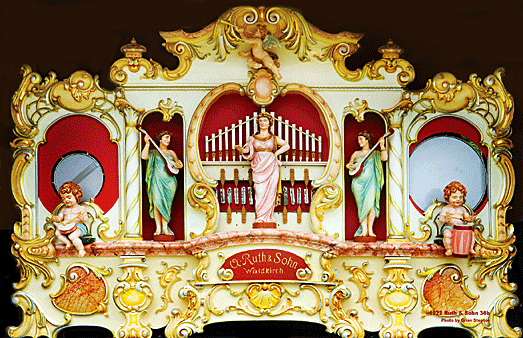
An automatic musical instrument can be compared to a data processing
machine. A piano roll stored Information that the organ retrieved in
logical order, resulting in music. Manufacturers used this basic
cylindrical system for many different types of automatic musical
instruments from petit music boxes to massive band organs. The
relationship between an automatic musical instrument and its rolls is
symbiotic—one needs the other because one cannot make music without the
other.
The Barrel Organ
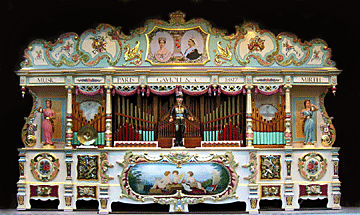 The
barrel organ, operated by a pinned wooden cylinder on which protruding
metal pins represented, was standard in the 19th century. The important
instruments of Bruder, Ruth, Gavioli, Fray Limonaire and other European
companies sold by the thousands in America. The decade from 1905 to 1915
saw the production of the most elaborate organs ever made. Most
distributors still imported large scale band organs from Europe, and
manufacturers tried to outdo each other with lavish facades. At
Cleveland's Euclid Beach Park, on the south shore of Lake Erie,
vacationers skated to the music of a 110-key Gavioli organ. At Coney
Island the carousel horses went around and around to lilting melodies
from a 94-key Bruder organ. The
barrel organ, operated by a pinned wooden cylinder on which protruding
metal pins represented, was standard in the 19th century. The important
instruments of Bruder, Ruth, Gavioli, Fray Limonaire and other European
companies sold by the thousands in America. The decade from 1905 to 1915
saw the production of the most elaborate organs ever made. Most
distributors still imported large scale band organs from Europe, and
manufacturers tried to outdo each other with lavish facades. At
Cleveland's Euclid Beach Park, on the south shore of Lake Erie,
vacationers skated to the music of a 110-key Gavioli organ. At Coney
Island the carousel horses went around and around to lilting melodies
from a 94-key Bruder organ.
But American companies had begun to take hold. In 1893, Eugene DeKleist,
a German former employee of Limanaire, established the North Tonawanda
Barrel Organ Factory in New York State. During the 1890s, this firm made
barrel organs, barrel-operated pianos, barrel-operated xylophones,
tubular chimes, and related instruments mainly for carousels and
amusement parks.
The Wurlitzer Monopoly
Beginning in 1897, DeKleist developed a working relationship with the
Rudolph Wurlitzer Company, founded in Cincinnati in 1856. By the early
1900s, Delfleist's factory had been renamed the DeKleist Musical
Instrument Manufacturing Company, and nearly all of its output went to
Wurlitzer, who acted as its sole agent in America. In 1909 Wurlltzer
acquired Kleist's company and moved its manufacturing operations to New
York. Wurlitzer manufactured many band organs, theater organs,
coin-operated pianos, and other instruments under the Wurlitzer name in
the city of North Tonawanda. The firm manufactured most of the band
organs, operated by pinned cylinders and referred to in Wurlitzer
catalogs as military band organs, between 1890 and 1905. From 1905 to
1910 there was a period of transition, while paper rolls became standard
after 1910. After 1920 most of the company's competition folded, leaving
Wurlitzer with a huge share of the market.
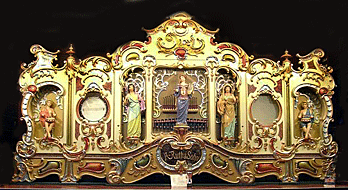 Meanwhile,
some of DeKleist's former employees founded the North Tonawanda Musical
Instrument Works in 1906. Confusion occurs because there were two
competing companies with similar names operating in the same city at the
same time. From then until the 1920s, it produced an array of
instruments under different names, including Capitol, Rand, Fox and
Electrotone. During the company's peak period from 1908 to 1914, their
military band organs were strong competitors for Wurlitzer and other
manufacturers. Meanwhile,
some of DeKleist's former employees founded the North Tonawanda Musical
Instrument Works in 1906. Confusion occurs because there were two
competing companies with similar names operating in the same city at the
same time. From then until the 1920s, it produced an array of
instruments under different names, including Capitol, Rand, Fox and
Electrotone. During the company's peak period from 1908 to 1914, their
military band organs were strong competitors for Wurlitzer and other
manufacturers.
The Mills Novelty Company, found in Chicago in 1890, was a leading
manufacturer of gambling devices with automatic musical products. In
1905 they marketed the Automatic Virtuosa, a device that contained a
real violin which played four strings by means of rotating rosined
celluloid discs which acted as bows. Metal "fingers" stopped each string
at appropriate length called for by the music roll. The company combined
this Automatic Virtuosa with a 44-note piano and renamed it the Violano-Virtuoso
in 1909. That same year the U.S. Patent Office included it among unusual
items with a high human interest for its exhibit at the Alaska
Yukon-Pacific Exposition. The exhibit provided the Mills Novelty Company
with a promotional windfall and sales for this instrument continued
until 1931.
Three Considerations Affecting Automatic
Musical Instruments
Three things have affected the survival of automatic musical
instruments. The time of
manufacture is an important consideration. Machines built before 1910
such as the Wurlitzer Automatic Harp and the Encore banjo became
obsolete by the 1920s when many were scrapped and replaced with smaller
cabinet-style automatic instruments. Businesses continued to use
machines made in the 1920s for several decades, so their survival rate
is much higher.
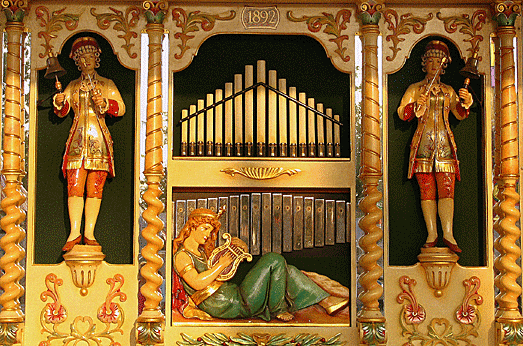
The original method of distribution is also an important consideration.
Automatic instrument manufacturers sold coin-op music boxes, pianos and
orchestrions either directly to a proprietor or to a route operator who
owned the instruments and put them in various locations. Restaurant
owners and other proprietors tended to shove their dated machines into
storage. Route operators scrapped their old machines because they
couldn't afford to store instruments that weren't bringing in revenue.
Floods, fires, insect infestation and urban renewal also claimed many
machines.
The smaller the instrument, the greater its chances of escaping
unscathed. A small tabletop music box could easily be moved to the attic
when the lure of the radio made it lose its appeal. When its popularity
waned, a small cabinet-style coin piano could be moved into a back room
for storage. But when massive band organs were no longer wanted, it was
much easier to tear them apart and sell the parts for scrap. Therefore,
fewer are available.
Escalating Prices
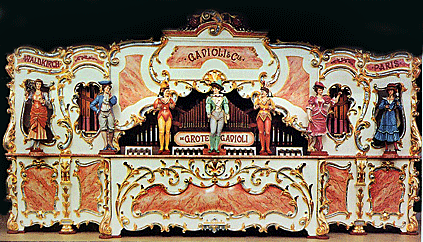 During
the 1940s through the early 1960s collectors of automatic musical
instruments could build huge collections for modest sums of money. The
majority of them lived in England, Holland, and the U.S. During
the 1940s through the early 1960s collectors of automatic musical
instruments could build huge collections for modest sums of money. The
majority of them lived in England, Holland, and the U.S.
By the end of the 1960s, increasing worldwide popularity brought higher
prices.
Investors, rather than collectors, purchased many machines during the
1970s and 1980s. This trend ended in the late 1980s. Today, even with a
hefty bank account, it’s difficult to enjoy music from these magnificent
large instruments at home. That’s because most automatic musical
instruments are now in the hands of collectors and preservationists who
cherish them and these items rarely are put up for sale. With many
people conducting a difficult search for a limited and dwindling supply
of desirable instruments, the results are skyrocketing prices.
<
Back
to More Antique Spotlights
Next Article >
|
